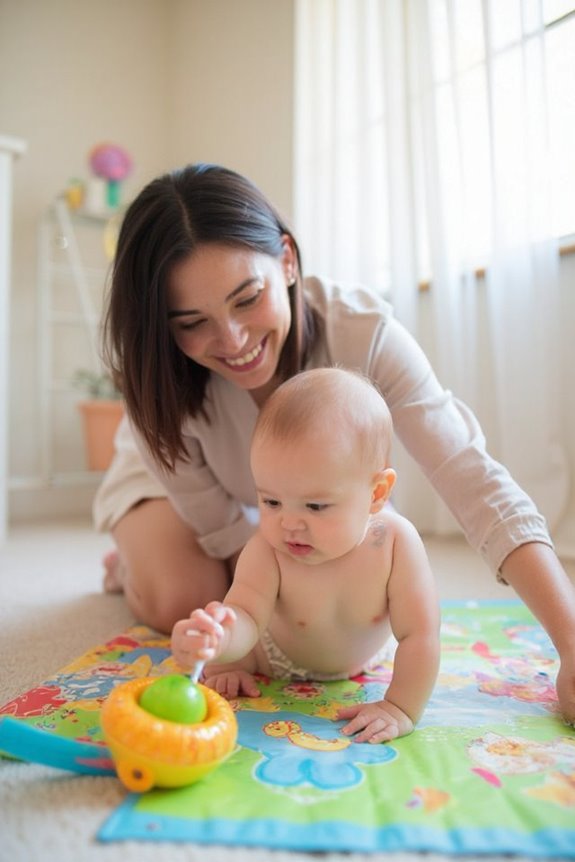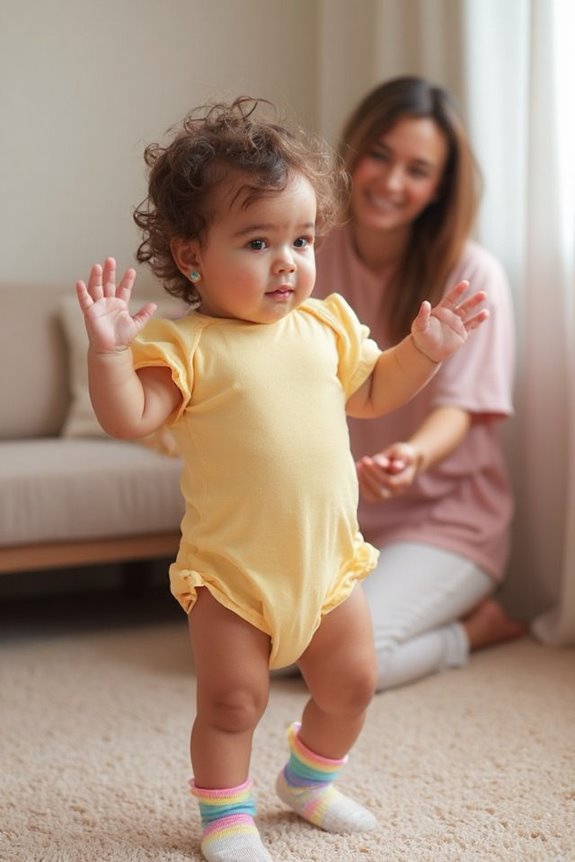Most babies start crawling between 6-12 months, with the average age being around 8 months. You’ll notice your little one rocking on hands and knees, pushing up during tummy time, or army-crawling before mastering the classic cross-crawl. Some babies skip crawling altogether, moving straight to walking. Don’t worry if your baby develops their own unique style—whether bear crawl, bottom-scoot, or belly drag—they’re still building essential physical and cognitive skills for future development.
Key Takeaways
- Most babies begin crawling between 6 and 12 months, with 7-10 months being the most common age range.
- Babies show readiness to crawl when they push up on straight arms and rock back and forth on hands and knees.
- Different crawling styles include classic cross-crawl, bear crawl, army/belly crawl, and unique variations like bottom-scooting.
- Crawling develops crucial muscle strength, coordination, and brain connections that benefit both physical and cognitive development.
- Some babies skip crawling altogether and move directly to pulling up and walking, which is a normal developmental variation.
The Average Timeline for Crawling Development
Most babies begin crawling between 6 and 12 months of age, with the sweet spot typically falling around 7 to 10 months. I’ve found that some early bloomers may start as young as 6 months, while others take their time and begin after 10 months—both scenarios are completely normal.
It’s important to remember that the average crawling age is just that—an average. Some babies skip this developmental milestone altogether, moving straight to pulling up and walking. Every child develops at their own pace, and comparing your baby to others isn’t helpful. If your little one was born prematurely, you’ll want to adjust your expectations based on their due date rather than birth date. What matters most is that they’re making progress in their own unique way.
Different Types of Crawling Methods

Babies showcase their unique personalities through at least five distinct crawling styles, each with its own developmental benefits. The classic cross-crawl pattern, where babies move on hands and knees, promotes balance and coordination. Many parents are surprised by the bear crawl, where little ones elevate their bottoms while moving on hands and feet.
I’ve observed that some babies prefer the army or belly crawl, dragging themselves forward using their arms and elbows—this builds impressive upper body strength. Less common crawling techniques include the crab crawl (sideways movement) and rolling from side to side. Some babies even develop their own variations like bottom-scooting or the leapfrog crawl. Don’t worry if your baby adopts an unconventional approach—all crawling styles contribute to their physical development and preparation for walking.
Physical Benefits of the Crawling Stage
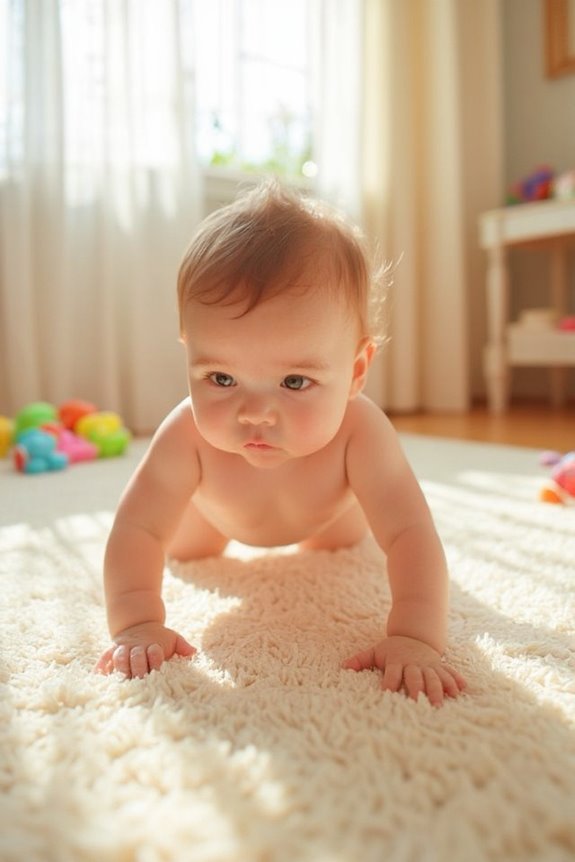
When your little one begins to crawl, they’re actually starting on a full-body workout that offers tremendous physical benefits. This milestone develops muscle strength throughout their entire frame, particularly in the shoulders, neck, back, and core.
Crawling strengthens upper body stability, which becomes vital for future activities like climbing and reaching. As babies coordinate moving opposite arms and legs, they gain invaluable body awareness that helps them understand how their body moves through space.
This developmental stage also enhances balance, posture, and bilateral integration—all essential foundations for walking. The repeated weight-bearing on hands and knees builds joint stability while promoting proximal strength in the shoulders and hips. These physical benefits extend far beyond babyhood, supporting your child’s ability to run, jump, and maintain good posture for years to come.
Cognitive Growth During the Crawling Phase
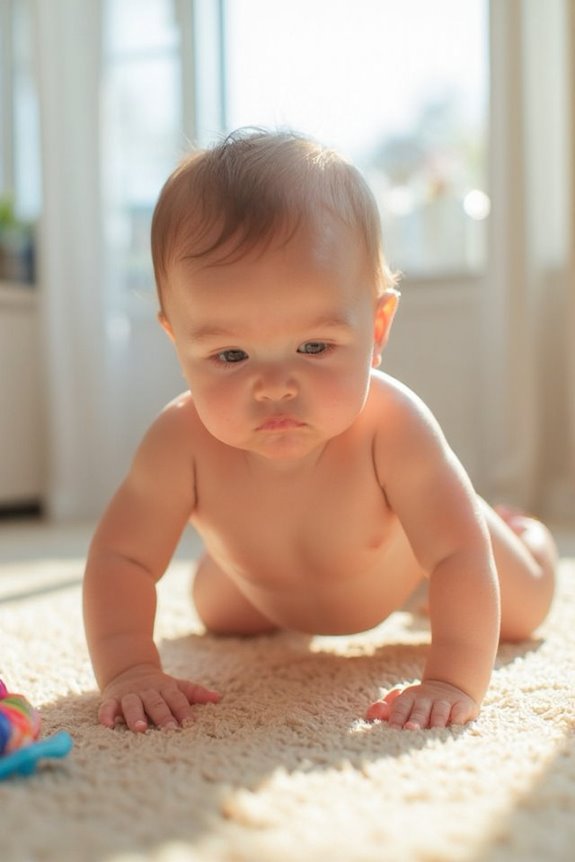
While your baby explores their newfound mobility, their brain is undergoing remarkable cognitive development. Crawling stimulates the corpus callosum, enhancing communication between brain hemispheres and strengthening neural pathways vital for focus and attention.
This milestone offers significant crawling advantages for cognitive growth. The cross-lateral movements help inhibit primitive reflexes like the Symmetrical Tonic Neck Reflex, which is essential for preventing learning disabilities. As your little one navigates different surfaces, they’re developing problem-solving skills, spatial awareness, and curiosity – all important cognitive milestones.
The brain-body connection strengthened during crawling supports your baby’s ability to understand distances, follow directions, and integrate thoughts into actions. This phase creates the neural foundation for future learning, making crawling much more than just physical development.
Setting Up a Crawl-Friendly Environment
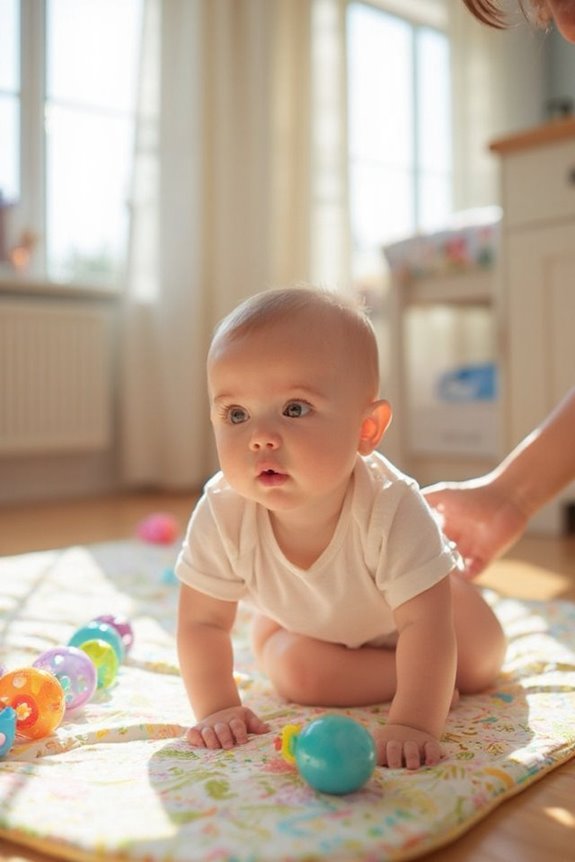
As your baby approaches the crawling stage, you’ll need to transform your home into a safe exploration zone. I recommend securing heavy furniture to walls and covering electrical outlets to prevent accidents. Don’t forget to install corner protectors on sharp furniture edges and gates at stairways.
Floor safety becomes essential during this phase. Guarantee hardwood surfaces are splinter-free and use non-slip rugs for added protection. Regular cleaning prevents slipping hazards that could frustrate your little explorer.
Creating designated safe play areas gives your baby freedom while maintaining your peace of mind. Get down on your hands and knees to spot potential dangers from your baby’s perspective. Remove small objects, secure loose wires, and teach family members to maintain these safety standards consistently.
Signs Your Baby Is Ready to Crawl
Most parents enthusiastically anticipate their baby’s first crawling attempts, which typically emerge between 6-10 months of age. As you watch your little one develop, several crawling readiness signs will appear before they’re fully mobile.
Look for your baby pushing up on straight arms during tummy time, rocking back and forth on hands and knees, or attempting the “down dog” position with bottom in the air. You might notice them army crawling—pulling forward with arms while their tummy remains on the floor—or pivoting in circles on their belly.
Mobility improvement indicators include your baby shifting between positions (sitting to hands and knees), scooting forward on their belly, or deliberately reaching for toys just beyond their grasp. Core strength development is essential, so encourage tummy time and create safe spaces for exploration as these preparatory movements emerge.
When to Be Concerned About Delayed Crawling
Should you worry if your baby hasn’t started crawling yet? While the 6-10 month range is typical, many babies develop on their own timeline. I recommend watching for patterns rather than fixating on a single milestone.
Legitimate causes concerns arise when your baby shows multiple developmental delays, retains primitive reflexes longer than expected, or displays neurological signs like unusual muscle tone. Premature birth, neuromuscular disorders, and nutritional deficiencies can all impact crawling development.
If your baby skips crawling but meets other milestones like sitting and standing, that’s usually fine. However, if you notice delays across several areas, it’s time to schedule developmental assessments with your healthcare provider. These evaluations can identify underlying issues and determine if specialized therapy might benefit your little one.
Supporting Your Baby’s Crawling Journey
Supporting your baby’s crawling development requires a thoughtful balance between encouragement and patience. I’ve found that consistent tummy time is one of the most effective baby exercises for building the necessary neck and shoulder strength.
Create a safe exploration space with varying textures and place favorite toys just beyond reach to motivate movement. When teaching crawling techniques, I suggest gently guiding your little one by positioning their limbs in crawling position or demonstrating the army crawl. Remember that each baby develops uniquely—some perfect the traditional hands-and-knees method while others prefer scooting or knee walking.
The key is consistency without pressure. Regular floor play sessions build confidence and coordination, but always follow your baby’s cues and celebrate small progress rather than rushing developmental milestones.
Alternatives to Traditional Crawling
While traditional crawling on hands and knees is common, many babies develop their own unique movement styles before walking. Some prefer the army crawl, moving on their tummies using elbows and arms to pull forward, which builds upper body strength.
Other alternative styles include bear crawling (using hands and feet with bottom up), bottom scooting, or scoot crawling (sitting and pulling with arms). These crawling techniques often emerge from factors like muscle development, environmental challenges, or even neurological preferences.
I’ve found that these variations aren’t cause for concern—they still promote important sensory input, problem-solving skills, and confidence. Cultural practices and family dynamics can also influence how babies move. Whatever style your little one chooses, they’re still working toward the same developmental milestones and will likely shift to walking when ready.
Frequently Asked Questions
Can Crawling Ability Predict Future Athletic Performance?
While crawling milestones unfold like petals of development, I’ve found they don’t predict athletic potential. I can tell you they’re important for motor skills, but they’re not crystal balls for future sports prowess.
How Do Crawling Patterns Differ Between Twins?
In my experience, twins often show different crawling milestones despite sharing genes. I’ve seen one twin master coordination earlier while the other develops unique patterns. They typically follow individual developmental timelines rather than identical ones.
Does Crawling on Different Surfaces Affect Developmental Progress?
I’ve seen millions of crawling babies adapt to different surfaces. Surface texture dramatically influences developmental milestones—hard floors promote faster crawling, while carpets build more strength. Each surface teaches different skills I’m watching develop.
Can Birth Order Influence When Babies Start Crawling?
I believe birth order can indirectly influence crawling through parental attention and expectations. While firstborns might receive more structured guidance, there’s limited direct research linking birth order to this specific developmental milestone.
Do Babies Who Skip Crawling Develop Differently Later On?
Yes, I’ve found that babies who skip crawling often develop differently. Crawling benefits include improved motor skills, stronger core muscles, and better brain hemisphere communication, which can impact learning abilities later in life.
References
https://www.babycenter.com/baby/baby-development/baby-milestone-crawling_6501
https://parentdata.org/is-crawling-important/
https://www.medicalnewstoday.com/articles/when-do-babies-crawl
https://parentingscience.com/when-do-babies-crawl/
https://www.pregnancybirthbaby.org.au/learning-to-crawl
https://www.healthline.com/health/baby/when-do-babies-crawl
https://www.pampers.com/en-us/baby/development/article/when-do-babies-crawl
https://huckleberrycare.com/blog/when-your-baby-starts-crawling
https://www.whattoexpect.com/first-year/crawling/
https://www.healthychildren.org/English/ages-stages/baby/Pages/Crawling-Styles.aspx



